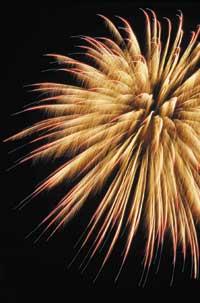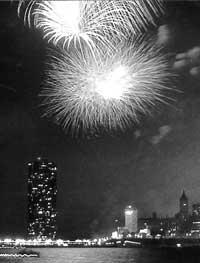Smokeless fires
2004/09/12 Galarraga Aiestaran, Ana - Elhuyar Zientzia
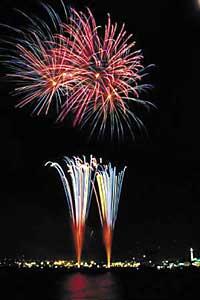
The key to getting smokeless fires is that they have not used gunpowder. Instead, compressed air has been used to send fireworks to the sky, so they have had no problem with smoke.
Conventional fireworks consist of two parts. The powder is placed at the bottom, where the wick is located. On the other side are the components that make up the show when exploiting artificial fire. Fireworks that happen with more than one explosion have more parts. Finally, they all carry a stick that corrects the direction of fireworks.
As soon as the wick is burned, the powder begins to burn and in this combustion a large amount of gas is generated. The gas comes out through holes prepared for it, which drives the rocket to the sky. Thus, it goes up at full speed until it reaches the height it will explode.
Releasing energy
Both children and adults follow the footprint of the rocket since the wick is lit, and when it explodes, that's the party! When artificial fire is made, sometimes it gives importance to sound, others to color, light or image, but the goal is always the same: that viewers enjoy the sky.
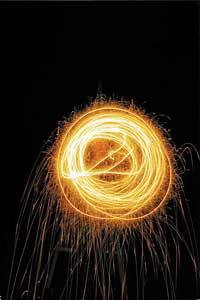
Today, in order to achieve the colour and luminosity of fireworks, producers are based on atomic emission. What is this phenomenon? For the responsibility of everything is of the electrons. The truth is that electrons revolve around the nucleus of the atom. But they do not choose anywhere to turn, but at the energy level.
By exploiting the rocket, energy is released in the form of heat that is absorbed by electrons. With this force, electrons jump to the next energy level. However, the new level is not stable and electrons have to return to the later energy level. In doing so they release energy as light.
All colors of the rainbow
In addition to brightness, color is one of the main characteristics of fireworks. And the color is clear. The color you see depends on the wavelength of the light. However, the eyes of men and women do not separate all wavelengths, they only see about 400 to 800 nm. To each length corresponds a color, the ubela being the color of less wavelength visible by the human being. The wavelength of the candle is 380-400 nm. At the other end is red, with a wavelength of 780 nm.
To get the desired colors it is essential to choose the ingredients well. For example, the orange color is obtained from calcium nitrate. This compound produces waves of 600-620 nm in length at the time of explosion, which is the corresponding to orange.
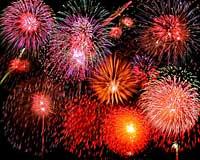
That said, it does not seem so difficult to get the desired colors, but it is a real art. And to master this art it is necessary to know a lot of chemistry. In addition to using the corresponding components, the chemical reactions that occur must be very controlled. Otherwise, unwanted molecules are formed that melt with colors.
The sky full of palm trees
Regardless of the colors, the images generated by the fireworks are not of any kind. Rings, parachutes, snakes, kites... manage to do everything. One of the best known figures is the palm, for which the rocket has bags full of a pyrotechnic mixture called ‘star’. Considering the location of these bags, the appearance of the palm appears in the sky.
Multilevel fireworks consist of several parts. Exploding a part turns on a device that causes a delay that causes the next part to explode. Thus, several explosions occur in a single rocket.
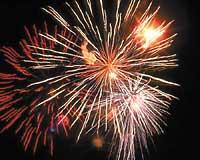
On the other hand, in the case of sparks, the measure matters: if you want sparks to last a long time, large particles must be used to make artificial fire. Because large particles stay warmer, the light lasts longer.
Air instead of gunpowder
All this is due to traditional fireworks. Those who are being used this year at Disneyland, however, are not very different. The difference is in a position to be discovered, since gunpowder is not used at Disneyland, but compressed air.
Because of this, they should not take care of the smoke, nothing will blur the show. In addition, fires reach further from gunpowder, up to 600 m. But… there’s always a ‘but’! Since there are no wicks, each artificial fire carries an electric device and a digital clock. Once the desired height is reached and following the indications of the clock, the device generates an electric spark that causes the artificial fire to explode. The result is spectacular, but that is quite expensive. They would surely include the expense of the new fireworks within the entrance fee to Disneyland!
Published in 7K.

Gai honi buruzko eduki gehiago
Elhuyarrek garatutako teknologia



